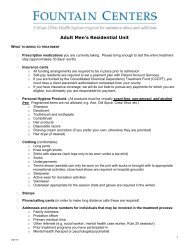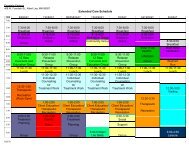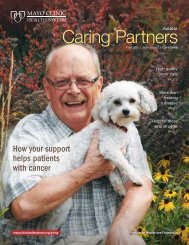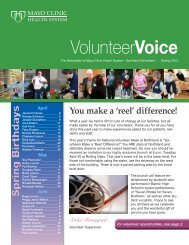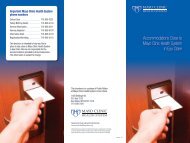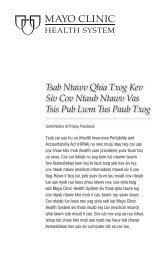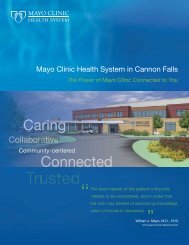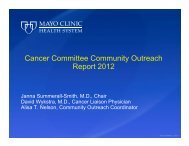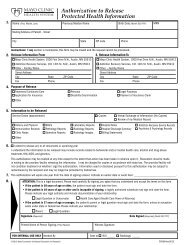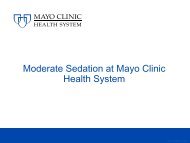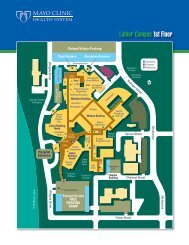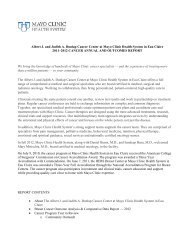MCHS Caring Partners LaCrosse 12 Page - MC6699-13
MCHS Caring Partners LaCrosse 12 Page - MC6699-13
MCHS Caring Partners LaCrosse 12 Page - MC6699-13
Create successful ePaper yourself
Turn your PDF publications into a flip-book with our unique Google optimized e-Paper software.
Spring 20<strong>13</strong><br />
<strong>Caring</strong> <strong>Partners</strong><br />
Your gifts | Your impact | Our thanks<br />
Intensive care<br />
requires<br />
intensive<br />
training<br />
PAGE 2<br />
Why hospice<br />
nurses<br />
think you’re<br />
wonderful<br />
PAGE 6<br />
Introducing<br />
the DAISY<br />
Award<br />
PAGE 8<br />
How you help 889 nurses<br />
to provide high quality,<br />
compassionate care<br />
mayoclinichealthsystem.org/giving<br />
Franciscan Healthcare Foundation
Your gifts at work<br />
Intensive care requires intensive training<br />
How your gifts help prepare critical care nurses<br />
On the cover:<br />
These nurses from<br />
the Family Birthplace<br />
are just a few of<br />
the 889 caring and<br />
capable nurses<br />
impacted by your<br />
generosity.<br />
New critical care nurses<br />
like Hanna Schank,<br />
right, receive intensive<br />
training thanks to<br />
your support. Hanna<br />
reviews an Essentials of<br />
Critical Care Orientation<br />
education module with<br />
input from veteran<br />
nurses Rose Peterson<br />
and Carrie Apuan.<br />
Clinical nurse specialist Rose Peterson has<br />
nearly 40 years’ experience in the intensive<br />
care unit (ICU) at Mayo Clinic Health<br />
System in La Crosse.<br />
Peterson says there was a time when<br />
the measure of a critical care nurse was<br />
his or her ability to respond to patient<br />
emergencies — something nurses call<br />
“running codes.”<br />
“But we don’t have many codes<br />
anymore,” says Peterson. “Today, it’s really<br />
about the critical care nurse preventing<br />
codes. Our training is to pick up on obvious<br />
and subtle clues; to carefully monitor<br />
patients to avoid complications.”<br />
Because that training is so important,<br />
new ICU nurses can expect to spend several<br />
months expanding their knowledge and<br />
honing their critical thinking skills before<br />
going it alone.<br />
Your contributions help provide a crucial<br />
component of their training.<br />
Essentials of Critical Care Orientation, or<br />
ECCO, is an online, interactive educational<br />
tool offered by the American Association<br />
of Critical Care Nurses. It provides new<br />
nurses with a comprehensive introduction<br />
to caring for critically ill patients. A<br />
series of modules guides nurses through<br />
increasingly complex material followed by<br />
knowledge tests.<br />
Thanks to your support, ECCO is a part<br />
of a blended approach to the orientation<br />
of new ICU nurses that also includes<br />
classroom time and caring for patients<br />
alongside experienced nurses known as<br />
preceptors.<br />
First piloted in the ICU in 2006,<br />
ECCO’s value was quickly apparent. The<br />
department requested Foundation funding<br />
so more nurses could access the program.<br />
Your gifts have helped support ECCO<br />
training since 2008.<br />
“Before ECCO, we made some<br />
assumptions about what nurses knew,”<br />
recalls Peterson. “We provided additional<br />
information as needed or requested, but<br />
their orientation wasn’t as complete as it<br />
is today. ECCO created an opportunity to<br />
standardize our approach.”<br />
Carrie Apuan is a<br />
registered nurse<br />
2 | mayoclinichealthsystem.org/giving | Learn more | Donate
Quality care in the ICU is a team effort. Nurses<br />
Rose Peterson and Carrie Apuan educate and<br />
nurture new critical care nurses, with your help.<br />
and the ICU patient care supervisor. She<br />
adds, “The goal with ECCO is to put all our<br />
nurses on the same page at the beginning<br />
of their ICU work experience so we<br />
know that, at a minimum, they have this<br />
foundational level of knowledge.”<br />
Apuan appreciates that ECCO helps<br />
account for the various ways people learn.<br />
“Some learn better by reading or watching<br />
a video; others through a more hands-on<br />
approach. By looking at ECCO test scores,<br />
we’re able to identify where nurses need<br />
more help and tie that into the classroom<br />
and into their clinical work with their<br />
preceptor.”<br />
ECCO also provides flexibility for nurses<br />
who come to the ICU with prior critical<br />
care experience. According to Peterson,<br />
“Our ultimate goal is to have new nurses<br />
complete 80 hours of ECCO education and<br />
pass the assessment test. If an experienced<br />
nurse joins the ICU and can pass the test,<br />
we forego the training, or we’ll tailor ECCO<br />
to include only areas where a nurse needs<br />
additional knowledge.”<br />
An essential skill of critical care nurses<br />
is the ability to build trusting relationships,<br />
particularly with patients’ families.<br />
Peterson and Apuan say it can be one of<br />
the most difficult skills for a new nurse to<br />
master.<br />
“ECCO actually includes a module<br />
on relating to families, building trust,<br />
managing difficult situations,” says Apuan,<br />
“but every nurse has to develop their own<br />
way of handling things. Building trust is<br />
According to<br />
the American<br />
Association<br />
of Critical<br />
Care Nurses:<br />
crucial, because<br />
while I may be a<br />
patient’s nurse<br />
today, tomorrow it<br />
may be someone<br />
else. If I’ve<br />
established a solid<br />
foundation of trust<br />
with a family, it<br />
carries over to the<br />
next person.”<br />
Equally vital to<br />
critical care nursing<br />
is a willingness<br />
to advocate for<br />
patients.<br />
Peterson says,<br />
“Educated nurses<br />
feel confident and<br />
it shows in the care<br />
they provide. It<br />
allows them to better<br />
advocate for patients because they’re not<br />
afraid to ask questions.”<br />
Peterson emphasizes, “In nursing,<br />
education plus experience equals critical<br />
thinking. So we start with education,<br />
nurture their experience — and from that,<br />
we have some really good nurses develop.”<br />
Asked what she would like to say to<br />
Foundation donors, Apuan says, “Your<br />
support is greatly appreciated. Your<br />
generosity ensures our nurses are well<br />
trained and thoroughly prepared to care<br />
for critically ill patients.”•<br />
Critically ill patients are those at high risk for life-threatening<br />
health problems. The more critically ill, the more likely a patient is<br />
to be highly vulnerable, unstable and complex, requiring intense<br />
and vigilant nursing care.<br />
Critical care nurses practice in settings where patients require<br />
complex assessment, high-intensity therapies and continuous<br />
nursing vigilance. Critical care nurses rely upon a specialized<br />
body of knowledge, skills and experience to care for patients and<br />
families and create a healing, humane and caring environment.<br />
Foremost, the critical care nurse is a patient advocate.<br />
Thanks<br />
to your support,<br />
ECCO is a part of a<br />
blended approach<br />
to the orientation<br />
of new ICU nurses<br />
that also includes<br />
classroom time<br />
and caring for<br />
patients alongside<br />
experienced<br />
nurses known as<br />
preceptors.<br />
| 3
Your gifts at work<br />
Novice nurses gain<br />
skills, confidence<br />
via simulator training<br />
Your support makes unique<br />
learning experience possible<br />
Student nurses care for “Noelle” in<br />
the Clinical Simulation Learning<br />
Center at Viterbo University.<br />
Thanks to your generosity,<br />
novice nurses in The Family Birthplace<br />
had the opportunity to experience an<br />
obstetric emergency, without a patient<br />
ever being in danger.<br />
Your support allowed 10 Family<br />
Birthplace nurses, each with less than<br />
two years of experience in labor and<br />
delivery, to participate in high-fidelity<br />
simulation training. The training<br />
took place at the Clinical Simulation<br />
Learning Center at Viterbo University<br />
in La Crosse.<br />
According to Kristin<br />
Schams, a registered<br />
nurse and certified<br />
nurse educator who<br />
coordinated the project,<br />
“This type of training is<br />
very different from what<br />
nurses typically receive on the job. It<br />
allows them to care for a patient in an<br />
emergency from start to finish, then<br />
debrief with educators to learn from<br />
the experience.”<br />
The “patient” in the simulation is<br />
named Noelle. Her fluctuating vital<br />
signs are displayed on a bedside<br />
monitor and she responds to the<br />
nurse’s questions as they perform their<br />
obstetric assessments.<br />
The nurses began their<br />
training at Noelle’s<br />
bedside with a briefing<br />
from registered nurse<br />
and obstetrics nursing<br />
educator Rachel Genz.<br />
“I worked with Kristen<br />
to develop the simulation scenario,<br />
which was a post-partum hemorrhage<br />
following a cesarean section,” says<br />
Genz. “It’s an obstetric complication<br />
that we had worked on in labor and<br />
delivery.”<br />
“Nurses who participate in this type<br />
of training will tell you the situation<br />
feels overwhelmingly real,” adds<br />
Schams. “It’s an intense and focused<br />
learning experience.”<br />
Simulation participant,<br />
registered nurse Chanda<br />
Humpal, agrees. “I was<br />
almost shocked by how<br />
realistic it was,” she says.<br />
“Noelle would say things<br />
like ‘I’m feeling light<br />
headed’ or, ‘my heart is racing.’ You<br />
just go into high alert and do what’s<br />
supposed to be done.”<br />
What did Humpal gain from the<br />
experience? “The most important<br />
thing was confidence. Overall, I felt<br />
we did really well, but there were<br />
a few things we could have done<br />
better.”<br />
Humpal appreciates that, “With<br />
the simulation, there’s no harm, so<br />
you don’t have to go home and beat<br />
yourself up. Instead, I know when<br />
I’m in that situation for real, I’ll be<br />
prepared.”<br />
This was the first time that hospital<br />
staff collaborated with Viterbo to<br />
do simulation training. Genz looks<br />
forward to other opportunities.<br />
“Anytime we can practice these types<br />
of critical thinking scenarios without a<br />
patient being at risk, it’s beneficial.”<br />
Schams sees future potential as<br />
well. “The simulation center can<br />
accommodate all types of nursing. The<br />
challenge is the personnel it takes to<br />
facilitate the experience. That’s where<br />
collaboration is essential.”<br />
Your collaboration was also vital<br />
to providing this exceptional learning<br />
experience for 10 novice nurses.<br />
Thank you for supporting nurses and<br />
nursing care at Mayo Clinic Health<br />
System — Franciscan<br />
Healthcare.•<br />
4 | mayoclinichealthsystem.org/giving | Learn more | Donate
Moms-to-be benefit from care options<br />
How you teamed with nurses to bring about new program<br />
Centering Pregnancy is<br />
a patient care option for<br />
moms-to-be. Here’s what<br />
they’re saying about the<br />
program you helped make<br />
possible:<br />
Research shows greater satisfaction<br />
among patients and health care providers<br />
who participate in “centering,” a model<br />
of care where patients see providers and<br />
receive education as part of a group.<br />
That’s been the experience<br />
of Kandi Holt, a registered<br />
nurse working in obstetrics.<br />
She says, “The Centering<br />
Pregnancy program has<br />
brought a new aspect to<br />
my work.”<br />
Your support allowed Holt and six<br />
colleagues to receive special training to<br />
bring Centering Pregnancy to La Crosse.<br />
Patients opting for the program have<br />
the same number of prenatal visits as<br />
those in traditional care, but rather than a<br />
15 to 20 minute appointment, they attend<br />
a 90-minute group session. Groups consist<br />
of eight to <strong>12</strong> women with a similar due<br />
dates. Sessions are facilitated by a nurse/<br />
midwife team who support the women<br />
throughout their pregnancies. Dads-to-be<br />
can also participate.<br />
With Centering Pregnancy’s set<br />
schedule of evening sessions, Holt says,<br />
“Patients don’t have to worry about<br />
making multiple appointments or fitting<br />
them into their workdays.”<br />
Sessions begin with members<br />
socializing and enjoying refreshments<br />
while visiting various stations. They<br />
weigh themselves, have their blood<br />
pressure checked and complete a selfassessment.<br />
They also have a private<br />
check up with the midwife.<br />
Later, there’s an educational<br />
presentation. “Providers appreciate<br />
Centering Pregnancy because they’re able<br />
to explain things in greater detail, then<br />
answer questions and gather feedback,”<br />
Holt says.<br />
Expectant moms like the extra support<br />
they receive. “They form friendships<br />
and share experiences,” says Holt. “And<br />
they develop strong relationships with<br />
us because we spend a lot of time with<br />
them.”<br />
Holt notes that the centering care model<br />
isn’t just for pregnancy. “Diabetes, for<br />
instance, can be treated in a group setting.<br />
It can also be an effective way to provide<br />
well-baby care.”<br />
With no additional cost to participate,<br />
Holt says, “I think Centering Pregnancy<br />
offers our patients a lot of bang for their<br />
healthcare dollar.”<br />
She adds, “Our nurses had been<br />
interested in offering Centering Pregnancy<br />
for some time before we were able to<br />
attend the training. We’re very grateful<br />
to Foundation donors for making that<br />
possible.”•<br />
“We received tons of<br />
information, and I liked<br />
sharing the experience<br />
with other women.”<br />
“I learned more because<br />
other people asked<br />
questions I wouldn’t have.”<br />
“I enjoyed the personal<br />
care and greater<br />
face-to-face contact.”<br />
“Meeting after work was<br />
great. It didn’t interfere<br />
with my schedule.”<br />
| 5
Nurses Jennifer Meyers,<br />
left, and Lisa Wick hold<br />
laptop computers that<br />
allow hospice nurses to<br />
access and document<br />
patient data wherever<br />
they provide care. You<br />
came to the rescue<br />
when older laptops<br />
proved troublesome.<br />
Your gifts at work<br />
Why hospice nurses think you’re wonderful<br />
Vexing technology glitch resolved, thanks to your generosity<br />
New technology can help streamline<br />
processes and make health care efficient.<br />
But sometimes, implementing new<br />
technology creates new headaches.<br />
Such was the case when the hospice team<br />
at Mayo Clinic Health System in La Crosse<br />
replaced its paper-based medical record<br />
system with an electronic, computer-based<br />
system, then extended “mobile access” to<br />
nurses in the field.<br />
You may be one of the many Franciscan<br />
Healthcare Foundation benefactors for<br />
whom hospice holds a special place. If so,<br />
you know that hospice provides medical<br />
care, emotional support and spiritual<br />
resources for persons in the final months of<br />
life. The program allows patients to receive<br />
care in the setting of their choice — at<br />
home, in a nursing home, or in a hospital.<br />
A Foundation grant, made possible<br />
through your support, helped purchase the<br />
software that gives hospice nurses secure<br />
access to medical records, regardless of<br />
where they are providing care.<br />
6 | mayoclinichealthsystem.org/giving | Learn more | Donate
Mobile access frees nurses from having<br />
to travel to the hospice office to review and<br />
update patient files. The new system also<br />
provides for more timely and thorough<br />
documentation of patient visits.<br />
And that’s a good thing,<br />
says registered nurse<br />
Jennifer Meyers, supervisor<br />
for hospice and home health<br />
services. “Patient care and<br />
safety are enhanced when<br />
everyone has access to the<br />
same information.”<br />
The headache came when, in an effort to<br />
keep costs down, the software was installed<br />
on existing laptop computers. It seemed a<br />
prudent plan until nurses discovered the<br />
laptops would often freeze up, requiring<br />
them to repeatedly reenter data. Frustration<br />
grew as attempts to resolve the problem<br />
proved unsuccessful.<br />
Meyers will tell you that hospice nurses<br />
are a special breed. “What we look for<br />
in a hospice nurse is compassion and<br />
empathy, but all of our nurses also have<br />
strong personalities. In the field you’re very<br />
autonomous and you can’t be afraid to make<br />
decisions. No one is standing over your<br />
shoulder telling you what to do.”<br />
Good listening skills are also essential.<br />
“Patients and family members may not be<br />
comfortable sharing their concerns with each<br />
other or with doctors,” says Meyers, “but<br />
they feel comfortable talking to that nurse.<br />
Sometimes people just need to vent a little,<br />
or they may need a shoulder to cry on.”<br />
Because the goal of hospice is comfort<br />
rather than cure, Meyers says nurses go into<br />
hospice with a different mindset. “Their role<br />
is to empower each patient to live the best<br />
life possible in whatever time they have left,”<br />
she says. “You either love being a hospice<br />
nurse or you don’t. Everyone is here because<br />
they want to be.”<br />
In 20<strong>12</strong>, nine hospice nurses and three<br />
home health aides made an astounding<br />
7,956 visits to hospice patients. “When you<br />
consider the documentation that must be<br />
done for each of those visits, there’s a lot of<br />
time involved,” says Meyers.<br />
With no apparent remedy for the freezing<br />
laptops and no money budgeted to replace<br />
them, the hospice department sought help<br />
from the Foundation.<br />
Thankfully, you came to the rescue — and<br />
hospice nurses couldn’t be more grateful.<br />
Your generosity provided a follow-up<br />
grant to purchase new, specially configured<br />
laptops that have made the nurses’ work<br />
much easier.<br />
“The original laptops caused a lot of<br />
frustration,” recalls Meyers. “Funding from<br />
the Foundation to replace them was huge.<br />
It affected morale — I can’t even tell you<br />
how much. We’re so grateful that people<br />
support hospice and helped us resolve this<br />
issue so our nurses can focus on providing<br />
compassionate care for patients and their<br />
families.”•<br />
<strong>Caring</strong> advice from a hospice nurse<br />
Lisa Wick,<br />
registered nurse<br />
and hospice<br />
coordinator<br />
In 20<strong>12</strong>, nine<br />
hospice nurses<br />
and three<br />
home health<br />
aides made<br />
an astounding<br />
7,956 visits to<br />
hospice patients.<br />
If registered nurse and hospice coordinator Lisa Wick<br />
could offer a bit of advice to people considering hospice<br />
care, it would be, “Don’t wait too long. We’re often called<br />
too late to provide patients and families the support they<br />
really need.”<br />
She recommends calling hospice when someone with<br />
a life-limiting illness has a change in appetite or is<br />
experiencing pain. “We can discuss their situation and<br />
help determine if hospice care is appropriate,” says Wick.<br />
The benefits are many. “A hospice nurse is a sounding<br />
board and an advocate for the patient. We’re there to listen and to<br />
help,” says Wick. She adds that the program also includes a chaplain,<br />
a medical social worker, counseling services and support groups.<br />
While cost is a frequent concern for families, Wick notes that Medicare<br />
and many private insurers cover hospice care.<br />
“When people don’t know what to expect, it creates a lot of anxiety,”<br />
she says. “Our team supports the patient and family throughout the<br />
process, and we stay connected with families for a year after their<br />
loved one passes.”<br />
| 7
Your gifts at work<br />
St. Clare Health Mission marks 20th anniversary<br />
Thanks to a generous and caring community<br />
When St. Clare Health Mission<br />
began caring for poor and uninsured<br />
members of the community in 1993,<br />
organizers hoped its doors would be<br />
closed in a few years.<br />
Two decades later,<br />
clinic director and<br />
registered nurse Sandy<br />
Brekke says that’s still<br />
the hope. “Ultimately,<br />
we want to go out of<br />
business because there’s<br />
no longer a need for our services.”<br />
Meanwhile, the Mission has<br />
provided more than 16,000 people<br />
with free medical care and medications<br />
during 64,000 clinic visits. Qualifying<br />
patients are ineligible for private or<br />
government health insurance and<br />
have incomes at or below 150% of the<br />
federal poverty guideline.<br />
Many see St. Clare Health Mission<br />
as a shining example of community<br />
collaboration.<br />
The unpaid, volunteer staff includes<br />
physicians, nurses, pharmacists,<br />
technicians, social workers and others.<br />
A number of the 350 volunteers have<br />
been with the Mission since it opened.<br />
Mayo Clinic Health System and<br />
Gundersen Lutheran continue to jointly<br />
sponsor St. Clare Health Mission,<br />
accepting referrals — at no cost —<br />
when patients need care beyond what<br />
the Mission can provide. Other local<br />
agencies, including La Crosse County,<br />
have also been closely involved.<br />
The Mission relies solely on<br />
charitable gifts and grants to fund<br />
operations. To date, more than 4,000<br />
individuals and organizations have<br />
provided financial support.<br />
Brekke began working at the Mission<br />
in 1994 under founding director,<br />
Sr. Leclare Beres. Asked why St. Clare<br />
Health Mission has survived — even<br />
expanded to include a Wednesday<br />
clinic for patients with chronic health<br />
conditions — while other free clinics<br />
have struggled, Brekke doesn’t hesitate.<br />
“It’s because of the support we<br />
receive from the community. People<br />
understand what we do here — that we<br />
care for people who otherwise could<br />
not see a doctor — and they have been<br />
very generous to us.”•<br />
Recognizing the super-human work of nurses<br />
Introducing the DAISY Award<br />
The La Crosse region has joined the other Mayo<br />
Clinic Health System locations as a participant<br />
in a national nursing recognition program —<br />
the DAISY Award for Extraordinary Nurses<br />
— designed to honor nurses who demonstrate<br />
exceptional skill and compassion at the bedside.<br />
The DAISY Award program is supported by<br />
a grant from the Sister Joyce Bantle Endowment<br />
within Franciscan Healthcare Foundation. Joyce<br />
Bantle was a nurse at Mayo Clinic Health System<br />
for more than 50 years. A 2004 gift in her honor,<br />
from the estate of Dorothy Jiracek, established the<br />
endowment.<br />
Each month an extraordinary nurse from<br />
Franciscan Healthcare is recognized. Nominations<br />
can be made by patients, visitors, employees and<br />
volunteers. DAISY Award recognition will also be<br />
part of the annual Nurses’ Day celebration, held the<br />
first week in May. •<br />
Nomination forms can be found at all Mayo Clinic Health System locations in the La Crosse<br />
region and are also available online at mayoclinichealthsystem.org/locations/la-crosse, search<br />
“daisy award.” They may be submitted via mail, web, or by calling (855) 392-4940 (toll free).<br />
8 | mayoclinichealthsystem.org/giving | Learn more | Donate
Gift planning<br />
A win-win: Tax incentives for charitable giving<br />
It can be challenging to keep track of<br />
all the proposals under consideration<br />
in Washington these days. Many issues<br />
turn into lengthy debates, and it can<br />
seem there’s no consensus in sight.<br />
Fortunately, the importance of<br />
charitable giving continues to be a<br />
rare point of agreement on both sides<br />
of the political aisle. There may be<br />
arguments over specifics, yet there is<br />
rarely disagreement with the notion<br />
that charitable giving should continue<br />
to be encouraged through favorable<br />
treatment in the tax code.<br />
While charitable intent — not tax<br />
incentives — should be the motivation<br />
to make a gift, it is also important to<br />
be aware of the rules established by<br />
Congress to encourage our giving.<br />
Little-known tax savings<br />
Most likely, you know that you can<br />
often receive an income tax deduction<br />
for your charitable contributions.<br />
But you can achieve substantial<br />
tax savings in other ways as well,<br />
depending on how a gift is structured.<br />
You may even be able to give away<br />
more, at a reduced cost, simply by<br />
taking advantage of the rules.<br />
For example, gifts of appreciated<br />
property — such as common stock that<br />
has been held for more than one<br />
year — may qualify for an income<br />
tax deduction and a reduction<br />
or avoidance of capital gains<br />
tax. Likewise, charitable<br />
gifts included in your will<br />
could reduce your estate<br />
tax liability. Gifts can<br />
take many forms, from<br />
cash to securities, real<br />
estate, grain, machinery,<br />
artwork, china, jewelry<br />
and much more.<br />
Gift in the future,<br />
benefit in the present<br />
Many benefactors are surprised to learn<br />
that they can commit to complete a<br />
gift in the future, yet enjoy tax benefits<br />
today. For instance, when giving a gift<br />
of real estate, you may continue to live<br />
in your home, or to enjoy your cabin,<br />
farm or other recreational property,<br />
while receiving an immediate tax<br />
benefit. You can enjoy these assets<br />
now with the knowledge that you are<br />
making a substantial future gift to<br />
enhance the health and well-being of<br />
your friends and neighbors.<br />
In addition, the law creates<br />
opportunities that may allow your<br />
gift to Mayo Clinic Health System to<br />
generate greater income for you or a<br />
loved one, while also benefiting the<br />
entire community through enhanced<br />
health care.<br />
If you’d like to learn more about the<br />
various ways the tax laws encourage<br />
charitable giving, please contact<br />
Peter Grabow at 608-392-9394 or<br />
grabow.peter@mayo.edu.<br />
Gifts can take many<br />
forms, from cash to<br />
securities, real estate,<br />
grain, machinery,<br />
artwork, china, jewelry<br />
and much more.<br />
Stock Certificate<br />
| 9
Your gifts at work<br />
The value of your gifts,<br />
from a nursing perspective<br />
An interview with Franciscan Healthcare Foundation<br />
board member and registered nurse, LuAnne Kratt<br />
“Your support is critical to our<br />
ability to provide high quality,<br />
compassionate health care.<br />
Be assured that your gifts are<br />
used wisely, for the greatest<br />
good, and for the benefit of<br />
many.”<br />
LuAnne Kratt<br />
What inspired you to<br />
become a nurse?<br />
After earning a degree in<br />
recreation leadership, I moved<br />
to Sheboygan to accept a job<br />
at a YMCA. I’d been there<br />
just a few months when I fell<br />
and broke my leg, requiring<br />
a lengthy hospital stay. Being<br />
new to the community and not<br />
wanting my family traveling<br />
across the state to sit with me,<br />
I was alone much of the time.<br />
Realizing this, one of the<br />
nurses spent a lot of time with<br />
me. She kept me company and<br />
provided wonderful care. Later,<br />
when I decided to make a career<br />
change, I chose nursing because<br />
of the wonderful experience I had<br />
and also because my mom is a<br />
nurse. It felt like a good fit.<br />
Why have you chosen to<br />
spend your nursing career<br />
at Mayo Clinic Health<br />
System in La Crosse?<br />
I was lucky to be offered a<br />
job here while still in nursing<br />
school. It’s been a great place to<br />
work. I believe in the mission,<br />
vision and values of the<br />
organization; in providing the<br />
best care for every patient. I’ve<br />
been here 16 years and spent<br />
the last 14 in the emergency<br />
department where I’m currently<br />
the director of patient care.<br />
What are some of the<br />
challenges facing nurses<br />
today?<br />
We’re challenged daily to find the<br />
most efficient ways to provide<br />
the best patient care. We focus<br />
a lot on eliminating waste. As a<br />
director, I can’t do that myself. It’s<br />
critical that staff be involved in<br />
generating ideas and streamlining<br />
processes.<br />
Another challenge is that the<br />
patients we see are sicker than<br />
in the past. Many are living with<br />
chronic conditions that would<br />
have been life-ending years<br />
ago. Emergency department<br />
nurses have to be at the top of<br />
their games. They may care for a<br />
week-old infant one minute and<br />
an elderly person the next. That<br />
requires broad knowledge and the<br />
ability to act decisively.<br />
What are the greatest<br />
opportunities for nurses<br />
today?<br />
The opportunity to share in<br />
decision-making has been<br />
part of our nursing culture at<br />
Mayo Clinic Health System for<br />
many years. Even as an entry<br />
level nurse, you can serve on<br />
councils in the department.<br />
And there are opportunities to<br />
be involved in practice issues<br />
at the system level as well.<br />
10 | mayoclinichealthsystem.org/giving | Learn more | Donateearn more | Donate
How does the Foundation<br />
support nurses in their<br />
work?<br />
I’ve seen a lot of support for<br />
nursing education. Those<br />
opportunities keep nurses engaged<br />
and bring best practices to our<br />
organization. In our area, we’ve<br />
received funding for training<br />
equipment and supplies. The<br />
Foundation also supported our<br />
pediatric cart, which is stocked with<br />
items to comfort kids being treated<br />
in the emergency department.<br />
What do you know about<br />
the Foundation now, that<br />
you didn’t know when you<br />
joined the board?<br />
My first involvement with the<br />
Foundation was co-chairing the<br />
employee division of the Through<br />
These Doors campaign in 2007. At<br />
the time, for me, it was about the<br />
Foundation helping us establish<br />
a beautiful, state-of-the art<br />
emergency and urgent care center.<br />
Now, I know there’s so much more<br />
the Foundation does. It’s very<br />
instrumental to the strength of the<br />
organization. For instance, without<br />
Foundation support of process<br />
improvement initiatives, I doubt we<br />
could have progressed so quickly.<br />
I’ve served on other boards<br />
where members are largely figure<br />
heads. This board is passionate.<br />
They help raise money and they<br />
know how it’s being spent. I enjoy<br />
hearing input from fellow board<br />
members as we consider<br />
funding requests.<br />
What do you find most<br />
rewarding about your board<br />
service?<br />
I like knowing that we’re making<br />
good decisions in supporting<br />
our local healthcare programs<br />
and services. And it’s rewarding<br />
to know how many people we<br />
touch, in one way or another,<br />
through that support.<br />
As a nurse, I’ve been able to<br />
share with other board members<br />
how Foundation funding has<br />
affected me and the patients I<br />
care for. I also appreciate the<br />
opportunity to hear from groups<br />
seeking Foundation support. It’s<br />
given me a deeper appreciation for<br />
the work of my colleagues across<br />
the organization.<br />
If you could speak directly<br />
to a Foundation donor,<br />
what would you say?<br />
I don’t think it’s possible to<br />
measure the importance of your<br />
gifts. Your support is critical to<br />
our ability to provide high quality,<br />
compassionate health care. Be<br />
assured that your gifts are used<br />
wisely, for the greatest good, and<br />
for the benefit of many.•<br />
Nurses in the emergency department are among the 889 nurses who<br />
benefit from your generosity. “Emergency department nurses have to<br />
be at the top of their games,” says Kratt.<br />
| 11
Franciscan Healthcare Foundation<br />
700 West Ave S<br />
La Crosse, WI 54601-4796<br />
NON-PROFIT ORG.<br />
U.S. Postage<br />
PAID<br />
Mayo Clinic<br />
Miceks<br />
recognized<br />
with Spheres<br />
of Influence<br />
Award<br />
Award recipients Ernest and Sally Micek at<br />
center, with Franciscan Healthcare president and<br />
CEO Tim Johnson, M.D., left, and Foundation<br />
executive director Peter Grabow, right.<br />
Ernest and Sally Micek were honored with Franciscan Healthcare Foundation’s<br />
Spheres of Influence Award at a gathering of Mayo Clinic Health System leaders and<br />
special guests.<br />
The Foundation has presented the Spheres of Influence Award annually since 1983 in<br />
recognition of those who generously support the organization’s healing mission.<br />
The Miceks are natives of Arcadia, Wis. Sally is a graduate of the St. Francis School<br />
of Nursing. Ernest served as president and CEO of the Cargill Corporation. Following<br />
his retirement, the couple settled in Dresbach, Minn. Since then, their generosity has<br />
benefited numerous organizations across the region.<br />
According to Foundation executive director Peter Grabow, “The Miceks<br />
have been very generous to the Cancer Center and to St. Clare Health Mission.<br />
And, it was Ernie and Sally who provided the gift that put the Foundation<br />
over goal in both the $8.3 million fund drive for the Center for Advanced<br />
Medicine and Surgery, and the $4.4 million campaign for the Emergency and<br />
Urgent Care Center.”<br />
“Philanthropy has played a key role throughout the history of Franciscan<br />
Healthcare,” Grabow notes. “In 1883, generous community support allowed<br />
the Franciscan Sisters of Perpetual Adoration to equip and furnish the original<br />
St. Francis Hospital so they could begin receiving patients. Philanthropy<br />
remains an equally vital part of our healing mission today.”<br />
In presenting The Miceks with the Spheres of Influence Award, the<br />
Foundation recognizes their philanthropic leadership in the community and<br />
extends its heartfelt appreciation for their generous support.•<br />
<strong>Caring</strong> <strong>Partners</strong><br />
<strong>Caring</strong> <strong>Partners</strong> is published twice yearly for the friends and<br />
benefactors of Mayo Clinic Health System.<br />
Information for <strong>Caring</strong> Partner stories is provided by Mayo Clinic Health<br />
System medical professionals. If you have medical questions about these<br />
stories and how they affect your health, please contact your physician.<br />
Mayo Clinic Health System - Franciscan<br />
Healthcare Foundation is a 501(c)3<br />
not-for-profit corporation. Gifts to the<br />
Foundation are tax deductible to the full<br />
extent allowed by law.<br />
mayoclinichealthsystem.org/giving<br />
• Learn more about the Foundation<br />
• Make a donation<br />
• News & Events, FAQs and more<br />
MAYO CLINIC HEALTH SYSTEM<br />
mayoclinichealthsystem.org<br />
©20<strong>13</strong> Mayo Foundation for Medical Education and Research. All rights reserved. MAYO, MAYO CLINIC, Mayo Clinic Health<br />
System and the triple-shield Mayo logo are trademarks and service marks of MFMER.



